Welcome to our blog on Guinea Hog facts! This article will delve into the fascinating world of Guinea Hogs, exploring their origin, size, physical characteristics, pros, and cons. These unique heritage pigs have a rich history and cultural significance, making them an intriguing breed to learn about. We’ll uncover interesting tidbits about their origins and regional variations and dive into their average weight and height. Additionally, we’ll examine their distinct physical features and discuss the benefits and drawbacks of owning these remarkable animals.
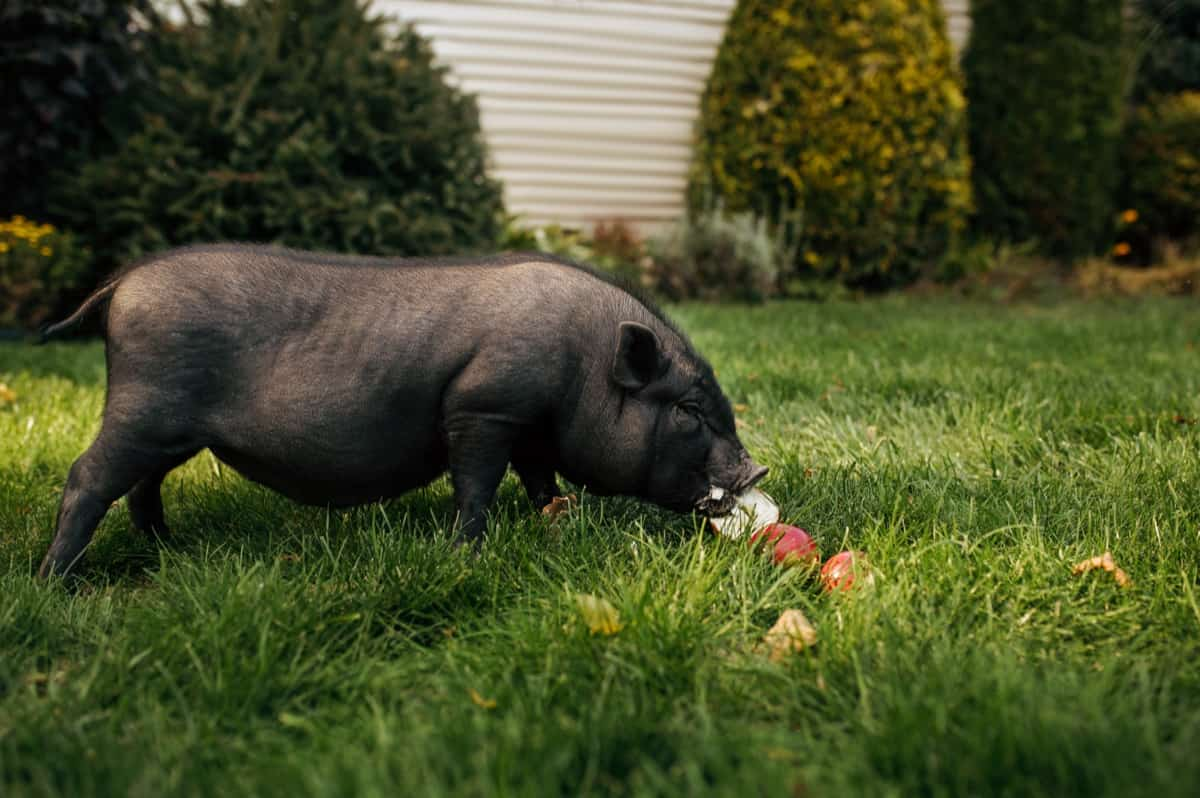
Guinea Hog Facts
What is the Guinea Hog Breed?
The Guinea Hog is a small black pig breed native to America, officially known as the American Guinea Hog since 2006. Its origins remain a mystery, although some theories suggest a possible connection to the Essex pigs from eastern England. However, it should be noted that it is distinct from an older breed called the Guinea Hog or Red Guinea.
The American Guinea Hog is characterized by its rare black coat, sturdy body, curly tail, and upright ears. In North America, there are two types of Guinea hogs: the small-boned and large-boned varieties, with the latter having longer legs. There is also a type of Guinea hog found in South America.
Guinea Hog Origin Facts: History and Heritage of the Breed
- Guinea Hogs have an intriguing past. It is currently thought that “Guinea” merely refers to its diminutive size, like Guinea Cattle, likewise compact livestock types.
- The authentic African Guinea hogs were bigger, red breeds with erect ears, bristly hair, and long tails, suggesting a genetic impact from Nigerian black or Ashanti pigs. In 1804, Thomas Jefferson bought several slave-ship-brought pigs from Africa via the Canary Isles.
- Guinea hogs were originally black with a tinge of crimson, known as “red Guineas.” By the early 19th century, this variety was extinct. The American Guinea hog, a black Guinea, lost its red tinge but kept its black hue.
- Subsistence farmers prized these pigs because they could forage and eat snakes, making the farmyard safer for children and cattle.
- Guinea hogs became unpopular, endangering extinction. The American Guinea hog’s link to other breeds is still being determined as red Guinea no longer exists.
- However, reddish piglets born to bluish-black American Guinea parents suggest a link. The Guinea hog is listed in Slow Food USA’s Ark of Taste, and the American Guinea Hog Association was founded in 2005 to protect the breed.
In case you missed it: Large White Pig Facts: Origin, Size, Physical Characteristics, Pros, and Cons
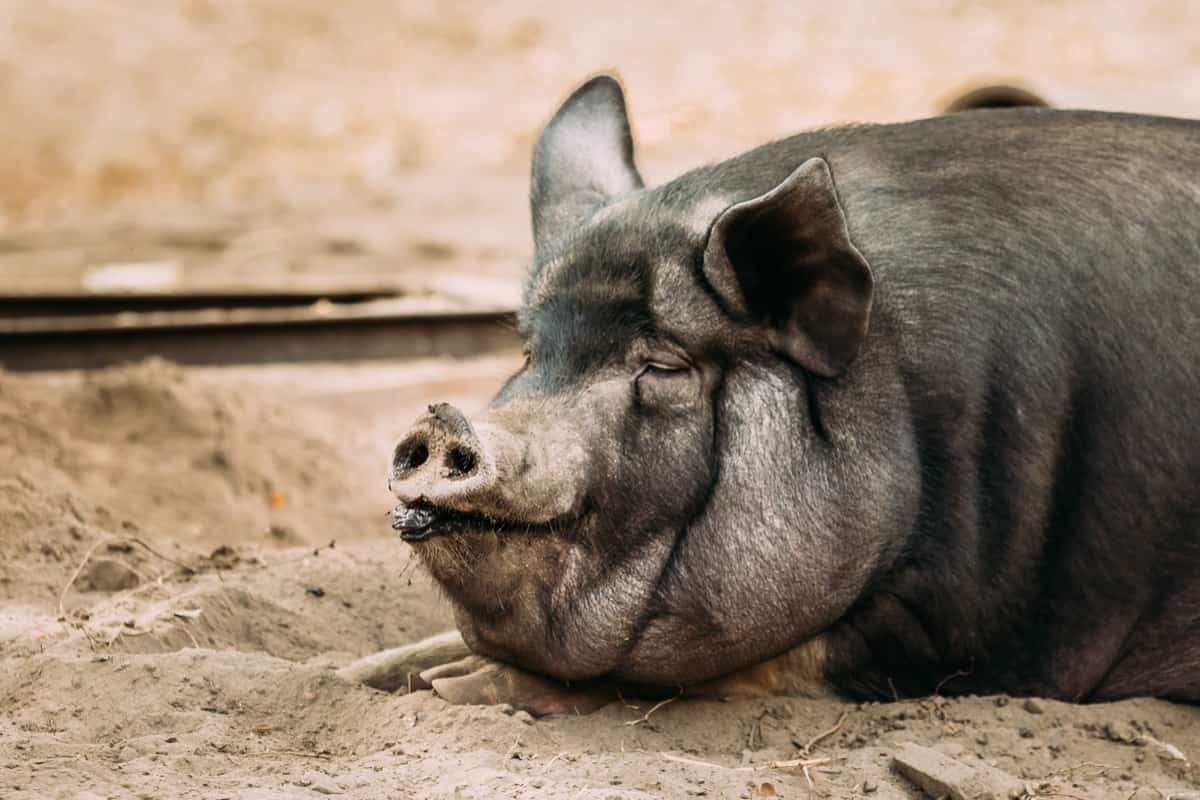
Guinea Hog Size Information: Average Weight and Height
The Guinea Hog or the American Guinea Hog, Acorn Eater, Guinea Forest Hog, Pineywoods Guinea, and Yard Pig, is a breed native to the United States. When it comes to their size, adult Guinea Hogs typically weigh between 69 and 135 kilograms (150 to 300 pounds). In terms of height, they typically stand at around 38 to 51 centimeters (15 to 20 inches). These measurements give us an idea of this breed’s average weight and height range.
Physical Characteristics of Guinea Hogs: Coat Color, Body Shape, and Features
- Origin: The American Guinea Hog is a heritage breed originating in the southeastern states of the USA, with a possible European ancestry and other influences. It has been confirmed as a distinct breed through genetic testing.
- Height: Adult Guinea Hogs range from 22 to 27 inches tall at two years of age. Males may be slightly taller than females, and older animals can grow larger.
- Body/Length: Fully grown Guinea Hogs measure from 46 to 56 inches in length, from the point between the ears to the base of the tail. They have a straight to slightly arched back and present a long, rectangular appearance with flat sides and rounded corners. Variations in body shape are common.
- Weight: Well-conditioned adult Guinea Hogs weigh between 150 and 300 pounds, depending on sex, frame size, and body condition. Overfeeding, especially with grain, should be avoided to prevent excessive weight gain and potential fertility problems.
- Head/Face/Ears/Tail: Guinea Hogs have medium-small sized, upright ears and slightly dished faces with varying snout lengths. Their tails have a single curl, and they typically have slightly forward-facing eyes.
- Color: Most Guinea Hogs have a solid black coat. A common variation is a solid black with minimal white points at the feet and nose tip. Excessive white is discouraged, although an extremely rare recessive red gene may occasionally appear.
- Hair: Adult Guinea Hogs have medium to long, coarse, bristled black hair, with some displaying reddish-brown or bluish-black tones.
- Temperament: Guinea Hogs are known for their calm and friendly nature, making them an excellent choice for small sustainable family farms. They exhibit exceptional mothering skills and get along well with children and farm animals.
- Living Environment: Guinea Hogs thrive in various environments but prefer lush pastures with clover. They require access to minerals, kitchen scraps, quality hay in winter, clean water, a muddy wallow, minimal shelter, dry bedding, and possibly a small grain. Regular exercise from ranging and grazing is beneficial for their well-being.
- Life Expectancy: The American Guinea Hog has an average lifespan of 10-15 years or until they are ready for culling and slaughter as farm livestock, providing high-quality meat.
- Carcass: At six months of age, Guinea Hogs can yield a nicely marbled carcass of up to 75 pounds hanging weight, with gourmet-quality, highly-flavored meat. The fat tends to peel easily from the meat, and young male hogs intended for slaughter at this age do not require castration.
In case you missed it: Hampshire Pig Facts: Origin, Size, Physical Characteristics, Pros, and Cons
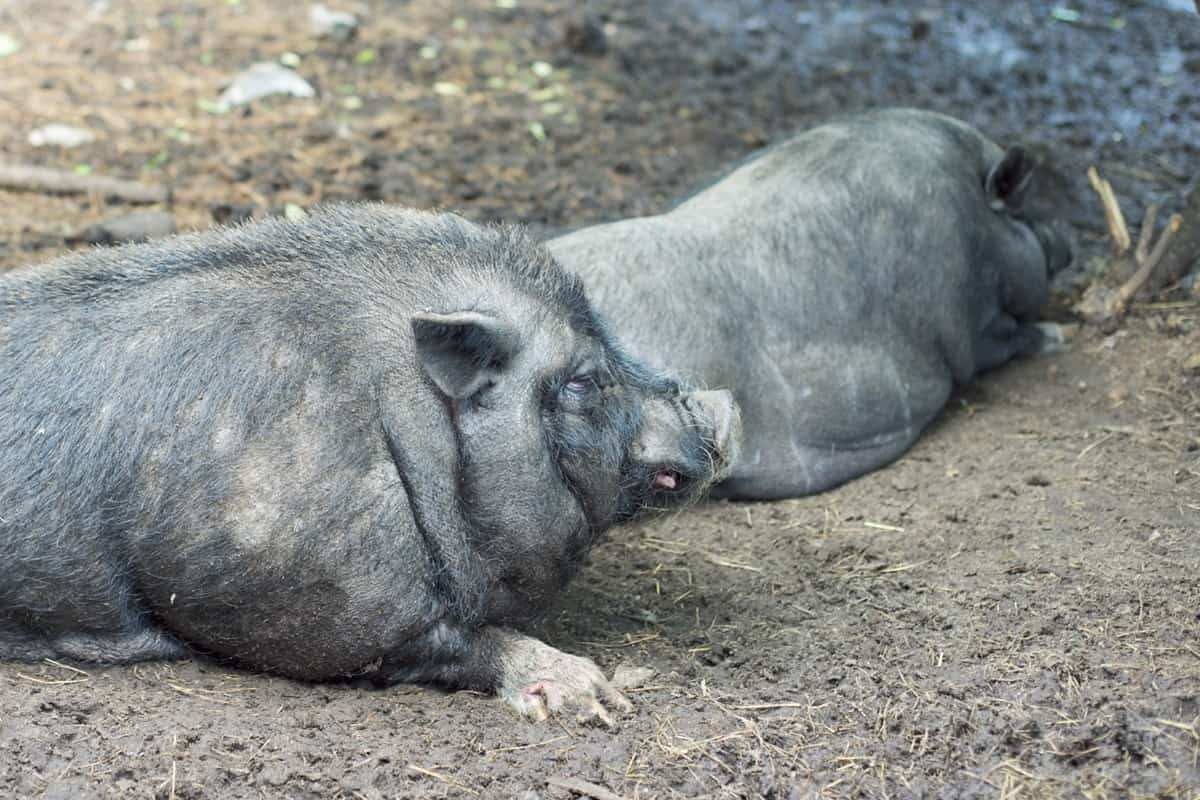
Pros of Owning Guinea Hogs as Livestock
Friendly Disposition: American Guinea Hogs are calm and docile, making them easy to handle and work with, especially in close confinement. They get along well with other animals, including chickens, and are often chosen as pets.
Excellent Mothering Skills: These hogs possess natural mothering capabilities and can farrow without assistance. Their gentle temperament makes them ideal for managing the farrowing process.
Perform Well on Poor Forage: American Guinea Hogs excel at grazing and prefer grass. They are highly efficient at utilizing pasture and can feed themselves on poor-quality forage, reducing feed expenses. They are excellent foragers and enjoy rooting and digging for their food.
Minimal Rooting: Unlike some other pig breeds, American Guinea Hogs have minimal rooting behavior. As long as they have access to good pasture and ample food, they cause minimal damage to the land.
Gourmet Quality Meat: These hogs are renowned for their excellent meat quality, particularly the lard they produce. Gourmet chefs highly prize the meat for its marbled fat, enhancing flavor. American Guinea Hog lard is abundant and can be used for cooking and baking. The meat is compared to Kobe beef for its exceptional flavor and rarity.
Cons of Raising Guinea Hogs
- Small Size: American Guinea Hogs are relatively small compared to other hog breeds, weighing around 250-300 pounds at their heaviest. This size disadvantage made them less popular in factory farm settings.
- Easy to Overfeed: One challenge of raising American Guinea Hogs is their tendency to gain weight rapidly. As lard pigs, they are prone to putting on fat quickly, especially when fed grain. Overfeeding can lead to poor meat composition, excessive fat content, and fertility problems.
In case you missed it: Large Black Pig Facts: Origin, Size, Physical Characteristics, Pros, and Cons
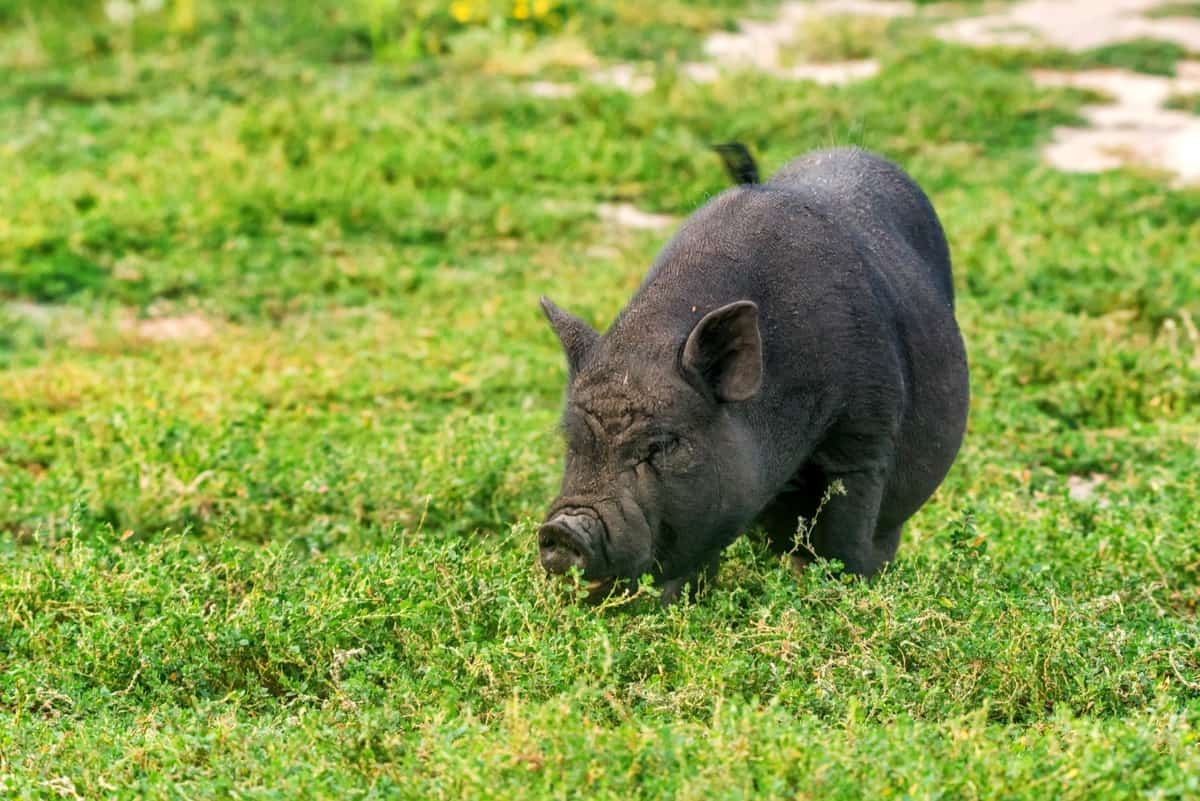
Interesting Facts about Guinea Hog
- Heritage Breed: Guinea Hogs are a true American heritage breed, dating back over 200 years, making them a valuable part of the country’s agricultural history.
- Compact Size: Guinea Hogs are smaller than industrial hog breeds, with adults weighing 150 to 300 pounds, making them suitable for small farms and homesteads.
- Foraging Abilities: These hogs have exceptional foraging skills and enjoy grazing on grass, rooting for insects, and eating a wide variety of vegetation, which reduces the need for additional feed.
- Excellent Temperament: Guinea Hogs are known for their friendly and docile nature, making them easy to handle and suitable for small-scale farming operations.
- Natural Mothering: Female Guinea Hogs exhibit strong maternal instincts and can farrow without assistance, making them ideal for raising piglets.
- Good Lard Production: Guinea Hogs are prized for their high-quality lard, which can be used for cooking and baking.
- Unique Meat Flavor: The meat of Guinea Hogs is highly regarded by gourmet chefs due to its fat-marbled quality, resulting in delicious and flavorful meat often compared to Kobe beef.
- Minimal Rooting: Unlike some pig breeds, Guinea Hogs have minimal rooting behavior and are less likely to cause damage to pastures and land.
- Conservation Efforts: The American Guinea Hog Association was founded in 2005 to preserve and promote the breed, ensuring its continued existence.
- Endangered Status: Guinea Hogs are considered an endangered heritage breed, emphasizing the importance of efforts to conserve and protect these unique pigs with their rich history and valuable characteristics.
Tips for Raising American Guinea Hogs
- Adequate Space: Provide sufficient space for American Guinea Hogs to roam and forage. They are active grazers and enjoy rooting around for food. Aim for at least 200 square feet per hog to ensure they have enough room to move comfortably.
- Pasture Access: Allow access to lush pastures with clover for grazing. Guinea Hogs thrive on grass and will help reduce your feed expenses. Ensure the pasture is well-maintained and free from harmful plants.
- Foraging Opportunities: Encourage natural foraging behavior by allowing your hogs to root and dig. They enjoy finding insects, grubs, and plant roots, contributing to their overall diet.
- Balanced Diet: While American Guinea Hogs are excellent foragers, they supplement their diet with quality hay, minerals, and occasional kitchen scraps. Avoid overfeeding grain to prevent excessive weight gain.
- Shelter and Bedding: Provide a dry and sturdy shelter to protect your hogs from extreme weather conditions. Offer clean and dry bedding material, such as straw or wood shavings, for their comfort.
- Regular Health Checks: Schedule regular veterinary check-ups to ensure the health and well-being of your hogs. Vaccinations, deworming, and parasite control are essential aspects of their care.
- Socialization: American Guinea Hogs are sociable animals. Introduce them to other farm animals gradually to promote positive interactions and reduce stress.
- Balanced Breeding: Plan your breeding program carefully to maintain the breed’s desirable traits and temperament. Avoid overbreeding and monitor the health and fertility of your hogs.
In case you missed it: Wessex Pig Facts: Origin, Size, Physical Characteristics, Pros, and Cons
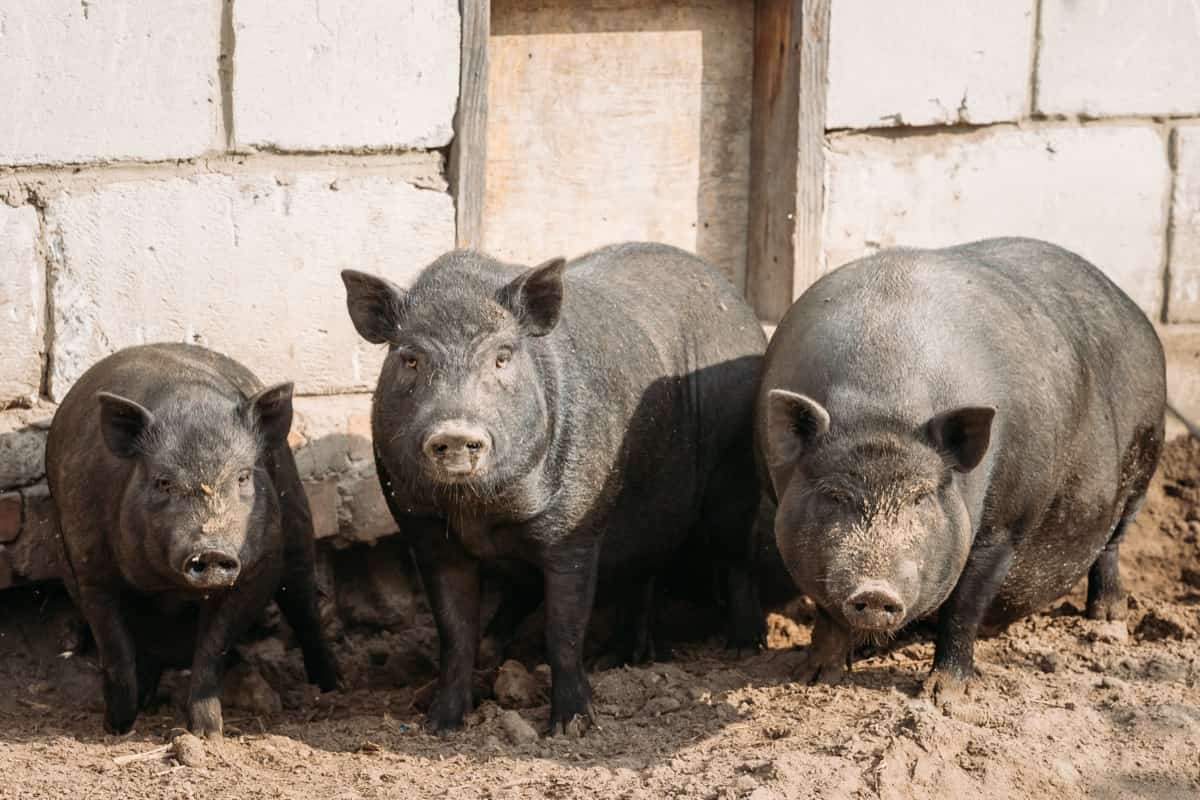
Guinea Hogs as Pets
Although not as popular as Potbelly pigs or Kunekune pigs, Guinea Hogs are among the smaller pig breeds that can be kept as pets. They have a friendly disposition and are suitable for smaller living spaces. Guinea Hogs offer a choice for those interested in having pigs as pets.
Guinea Hogs Meat Flavour
Guinea Hogs meat is known for its delectable flavor, with a hearty taste and creamy, melt-in-your-mouth fat. It is sweet, buttery, and tender, even when reheated. The American Guinea Hog’s lard-producing qualities make the pork ideal for traditional cuts and for creating excellent charcuterie.
The amount of pork obtained from an individual AGH varies due to differences in size and build, but on average, one can expect to harvest 50-65% of the live hog weight when choosing traditional cuts. The percentage increases when utilizing other hog parts for bone broth, scrapple, head cheese, and jowl bacon.
Lifecycle of Guinea Hogs
The lifecycle of American Guinea Hogs begins with a gestation period of around 114 days. The docile mothers give birth to litters of piglets without assistance, usually creating nests from available materials. Piglets are born small but grow quickly, reaching around 9 to 10 lbs by weaning at 5 to 8 weeks. Male pigs can be castrated at about 14 days of age if desired.
Males can breed at 6 to 8 months, while females can come into heat as early as eight months and give birth near or after their first birthday. Guinea Hogs can have 2 to 2.5 litters per year, with litter sizes ranging from 1 to 14 piglets. Butchering can occur as early as six months, with full size reached at 2 to 3 years, weighing approximately 200 to 300 lbs. They can live a fairly long time, with some reaching 13 or 14 years. It is advisable to breed females earlier to ensure their contribution to the gene pool.
In case you missed it: Auckland Island Pig Facts: Origin, Size, Physical Characteristics, Pros, and Cons
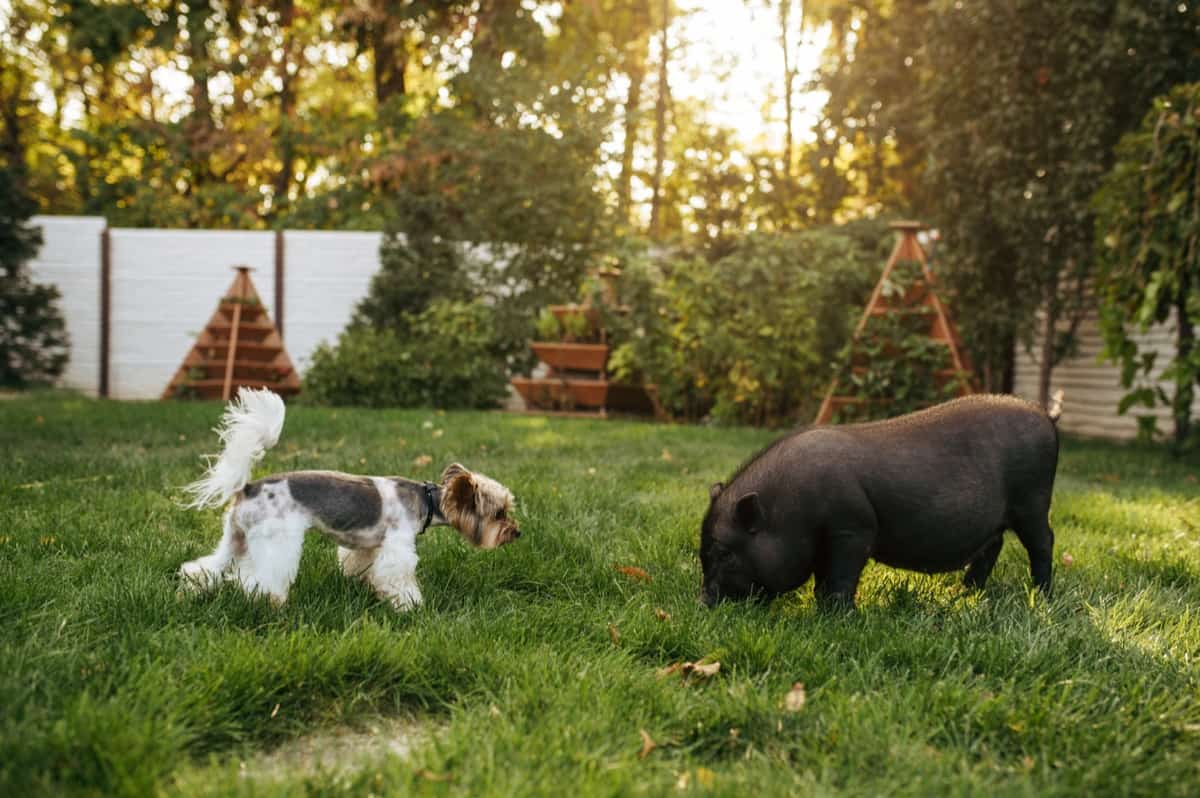
Conclusion
Guinea Hogs are a heritage breed of domestic farm pig with a rich history. They are known for their moderate size, friendly temperament, excellent foraging abilities, and prized meat. However, their small size and tendency to overeat are potential drawbacks.
- Goat Farming Training Programs in India: A Beginner’s Guide
- Types of Pesticides Used in Agriculture: A Beginner’s Guide
- Economical Aquaculture: A Guide to Low-Budget Fish Farming
- 15 Common Planting Errors That Can Doom Your Fruit Trees
- How to Make Houseplants Bushy: Effective Tips and Ideas
- Innovative Strategies for Boosting Coconut Pollination and Yield
- Pollination Strategies for Maximum Pumpkin Yield
- The Complete Guide to Chicken Fattening: Strategies for Maximum Growth
- Natural Solutions for Tulip Problems: 100% Effective Remedies for Leaf and Bulb-Related Issues
- Revolutionizing Citrus Preservation: Towards a Healthier, Greener Future
- Natural Solutions for Peony Leaf and Flower Problems: 100% Effective Remedies
- Maximizing Profits with Avocado Contract Farming in India: A Comprehensive Guide
- Natural Solutions for Hydrangea Problems: 100% Effective Remedies for Leaf and Flowers
- The Ultimate Guide to Choosing the Perfect Foliage Friend: Bringing Life Indoors
- From Sunlight to Sustainability: 15 Ways to Use Solar Technology in Agriculture
- The Ultimate Guide to Dong Tao Chicken: Exploring from History to Raising
- The Eco-Friendly Makeover: How to Convert Your Unused Swimming Pool into a Fish Pond
- Mastering the Art of Delaware Chicken Farming: Essentials for Healthy Backyard Flocks
- 20 Best Homemade Fertilizers for Money Plant: DIY Recipes and Application Methods
- How to Craft a Comprehensive Free-Range Chicken Farming Business Plan
- Brighten Your Flock: Raising Easter Egger Chickens for Beauty and Bounty
- How to Optimize Your Poultry Egg Farm Business Plan with These Strategies
- Subsidy for Spirulina Cultivation: How Indian Government Schemes Encouraging Spirulina Farmers
- Ultimate Guide to Raising Dominique Chickens: Breeding, Feeding, Egg-Production, and Care
- Mastering the Art of Raising Jersey Giant Chickens: Care, Feeding, and More
- Ultimate Guide to Raising Legbar Chickens: Breeding, Farming Practices, Diet, Egg-Production
- How to Raise Welsummer Chickens: A Comprehensive Guide for Beginners
- How to Protect Indoor Plants in Winter: A Comprehensive Guide
- Ultimate Guide to Grow Bag Gardening: Tips, Tricks, and Planting Ideas for Urban Gardeners
- Guide to Lotus Cultivation: How to Propagate, Plant, Grow, Care, Cost, and Profit
- Agriculture Drone Subsidy Scheme: Government Kisan Subsidy, License, and How to Apply Online
- Ultimate Guide to Raising Araucana Chickens: Breed Profile, Farming Economics, Diet, and Care
- Bringing Hydroponics to Classroom: Importance, Benefits of Learning for School Students
- Ultimate Guide to Raising Polish Chickens: Breed Profile, Farming Economics, Diet, and Care
- Ultimate Guide to Raising Australorp Chickens: Profile, Farming Economics, Egg Production, Diet, and Care
- Silkie Chicken Farming: Raising Practices, Varieties, Egg Production, Diet, and Care